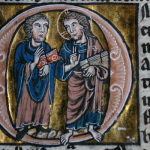HAPPY VALENTINE’S DAY! HERE’S A REVIEW OF “EYES WIDE SHUT”! Okay, the dumb basic response is that I’m really glad I saw this. That said (with some spoilers, so if you are like me and hate spoilers, please know that you should put this movie in your Netflix queue instanter, even though you will probably dislike it):
1. Sean Collins is obviously right that it’s a horror film. He gets at lots of the details that make it “‘Eyes Wide Shut,’ from the director of ‘The Shining’!”, and I agree with every word of his write-up; but I think he misses the dumb basic point: Most horror films have the moral, “Don’t!” And in that sense, EWS is a horror movie about committing adultery in your heart.
Don’t.
2. It’s so amazing, as a movie. The colors are astonishing–the cobalt blues and neon oranges of Van Gogh’s madness. The acting–I honestly didn’t know that Nicole Kidman or Tom Cruise could act at all, and now… yeah, okay. I get it. Especially for Kidman. She’s melodramatic in a way that makes it part of her character and her world; she makes every studied gesture a statement about the world in which all her gestures would need to be studied and perfect. The rushing, pulsing camera was amazing, especially in the taxi scenes. The ideas behind the movie–what if sex were the instrument of horror? what if physical contact weren’t necessary for that to happen?–are brilliant.
3. But.
The movie pulls back before the brink–before every brink. How are its protagonists changed by the end? What have their experiences cost them? I can’t think of anything.
The Cruise-Kidman couple have a daughter. I thought perhaps she would be the key to the movie: sex as generativity vs. sex as destructive weapon. That didn’t happen, which is fine–that particular opposition is something I feel like I understand pretty well, and I’d really be more intrigued by alternative dichotomies. (Horror, I think, feeds on dichotomies.) But Helena’s role in the plot turned out to be deeply disturbing to me: It seemed like she was a token doled out to the survivors as a reward for good behavior–like the blue and pink molded plastic figurines in the LIFE boardgame.
4. Nudity. EWS needed (female) nudity, in the way that Pauline Reage’s Story of O needs explicit descriptions. The movie tried hard to get us to recognize that we weren’t seeing girls’ bushes for no reason: The huge painting of a naked lady, in Ziegler’s suite, was probably the most obvious example. Her genitals were always hidden–ostentatiously hidden–by the scenery, whereas the actual genitals of the actress who played Ziegler’s brief inamorata were constantly on display. So clearly we’re supposed to think something about the fact that women’s bodies (and not male bodies, ever) are displayed for us here.
Well… not only did EWS ignore the most startling and compelling moods of O (the sunlight slanting through late afternoon) in favor of a cliched Black Mass orgy. More importantly, the strictures of Hollywood stardom (maybe?) required that Kidman never get quite as naked as her female cohorts. So we see them from the front, but she’s only naked from the back. That difference reinforces the sense already invited by the movie’s ending: There are good girls and bad girls. Good girls shouldn’t be cheated on, even in your head, and you should have sex with them and display their nudity tastefully from the back. Bad girls may get killed and raped and even photographed in full-frontal, and your only responsibility is to avoid them. No guilt attaches to you if you leave them to be destroyed.
In the end, I think EWS is a shocking, brilliant, hollow movie. Deep on the outside; shallow within.











